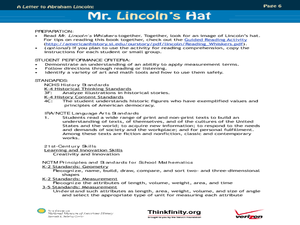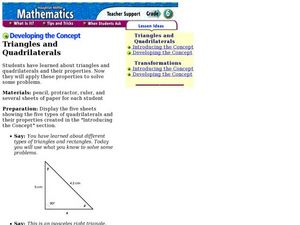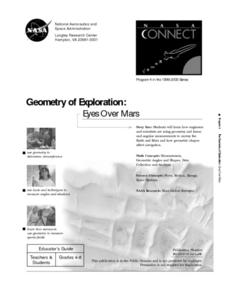Curated OER
Weather Dot Com
Students examine the need for a standard unit of temperature and measure temperature with a thermometer. They discuss the details of a thermometer and the calibrations used, record temperature data for inside and outside, explore...
Curated OER
Mr. Lincoln's Hat
Bring out the inner artist with this Abraham Lincoln lesson. Elementary young scholars work on a home project creating a hat similar to Abraham Lincoln's hat. They will use geometry and measurement to create the scale of the hat, then...
Curated OER
Types of Triangles
Fifth graders explore the required functions of the Geometer's Sketchpad. Using the computer software, they construct similar triangles and identify them by angles and sides. Students classify triangles. Afterward, they complete problems...
Dick Blick Art Materials
Start with a Circle...
The Golden Ratio. The Divine Proportion. Yup. It's math and art blended into one colorful activity. Young artists combine colored tissue paper circles and parts of circles to create geometric patterns. As a bonus, kids get to figure out...
Curated OER
Measurement
Students use arithmetic in a practical situation using time and distance.
As the calculations involved in this problem involve single digit addition and multiplication it offers a good opportunity to encourage the students's use of...
Curated OER
Congruence: Practice
In this congruence learning exercise, students trace figures, measure sides and angles, mark congruent sides and angles, then use a given diagram to answer questions and explain reasoning. Students also answer 2 test prep questions....
Curated OER
Tessellation Trial and Error
In this interactive instructional activity, students review attributes of equilateral polygons. They are introduced to the concept of a tessellation. Using protractors and pre-cut shapes, students arrange a variety of tiles to create...
Curated OER
Quadrilaterals and Other Polygons: Homework
In this polygons worksheet, learners classify each polygon in as many ways as possible. Students then write polygon or not a polygon to classify each figure and find the measure of the missing angles. Learners finish with one word problem.
Curated OER
Oranges and Stopwatches
Students measure various attributes of an orange. They discuss the attributes of an orange that can be measured, develop a list of attributes and describe how they can measure it, and rotate through four stations measuring the volume,...
Curated OER
Plenty of Pythagoras
Using a twelve foot knotted rope, students form a 3-4-5 right triangle. Following a discussion of observations about the lengths of the sides of the triangle, students use grid paper, scissors and a centimeter ruler to draw and measure...
Houghton Mifflin Harcourt
Developing the Concept: Triangles and Quadrilaterals
Exact narrative and examples make this lesson on polygons easy to implement. Through it, your class will learn how to use a protractor and ruler to construct triangles and quadrilaterals according to your directions. Your class will be...
Curated OER
Geometry of Exploration: Eyes Over Mars
Pupils research how engineers and scientists generate linear and angular measurements with geometry to survey the Earth and Mars. They assess how geometric shapes affect navigation. A surveyor comes to the classroom and explains how he...
Curated OER
Tally Time
Learners create a tally chart. In this math and health instructional activity, students discuss healthy foods and create a tally chart showing the number of learners who like to eat healthy foods.
Curated OER
Geometry in Tessellations
Young scholars examine tessellations and their geometric properties. Students explore the concept of tessellations and lines, planes, angles, and polygons. Young scholars experiment with the area and perimeter of polygons. Students...
Curated OER
Parallel and Perpendicular Lines
Learners study parallel and perpendicular lines. In this parallel and perpendicular lesson plan, pupils explore 2-D shapes and determine if the sides are parallel or perpendicular.
Curated OER
Area Lesson Plan
Learners manipulate a variety of materials and computer applets in order to explore area and the units used to measure it.
Curated OER
Visualizing Multiplication
Upper graders represent multiplication of a two-digit number by a two-digit number as the area of a rectangle with dimensions of the two factors. They find patterns for the number of different base ten blocks in a rectangle representing...
National Security Agency
Classifying Triangles
Building on young mathematicians' prior knowledge of three-sided shapes, this lesson series explores the defining characteristics of different types of triangles. Starting with a shared reading of the children's book The Greedy...
Arizona Department of Education
Area and Perimeter of Regular and Irregular Polygons
Extend young mathematicians' understanding of area with a geometry lesson on trapezoids. Building on their prior knowledge of rectangles and triangles, students learn how to calculate the area of trapezoids and other...
Curated OER
Regular Polygons
Fifth graders explore polygons. In this math instructional activity, 5th graders find examples of regular polygons in the classroom and measure the sides of figures to determine if they are regular polygons.
Curated OER
3D Objects
In this math instructional activity, students solve six problems about 3D objects. Students also solve six problems about measuring 3D objects.
Curated OER
Terrific Tessellations
Students create, transform, and critique their own piece of artwork. In doing this lesson, students get more experience working with angles, lines, and measurement. They gain experience seeing, and creating their own patterns and shapes.
Curated OER
Perimeter
Learners use their hands, feet, computer, and rulers to measure the perimeter of objects. For this measurement lesson plan, students measure objects around the room and computer generated shapes.
Curated OER
Problem Solving Using Power Polygons
Students investigate geometric shapes by creating figures on a plane. In this polygon lesson, students complete a worksheet based on the angles in a power polygon. Students identify the different types of polygons and define their...























